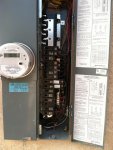Garbluck
Member
- Location
- Provo, UT, United States
Seems that the Jurisdictions in the Las Vegas area are going to require:
that no PV systems can be interconnected on the load side of a center-fed panelboard
Unless: The panelboard's Main breaker is 4 Pole
I don't understand the reasoning behind this, so my question in the title stands:
What's the difference between a main breaker that is 2 pole vs 4 pole?
that no PV systems can be interconnected on the load side of a center-fed panelboard
Unless: The panelboard's Main breaker is 4 Pole
I don't understand the reasoning behind this, so my question in the title stands:
What's the difference between a main breaker that is 2 pole vs 4 pole?



